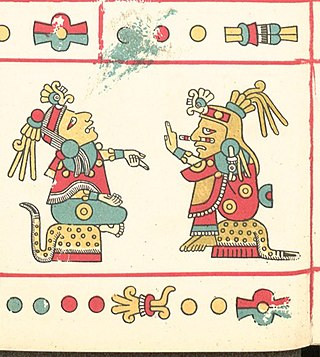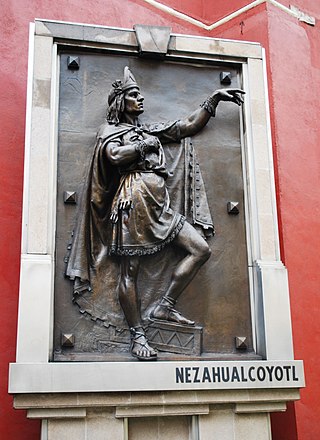Xayacamach of Tizatlan was an Aztec poet from the Pre-Columbian state of Tlaxcallan, born between 1450 and 1455.
He was the son of the "Señor de Aztahua de Tizatlan" (Lord of Aztahua of Tizatlan). He took his father's place as governor, and assisted at the meeting called by Tecayehuatzin of Huextonzinco to converse on the meaning of "flower and song", which is where we get both of his recorded poems. Tecahueyatzin said of him:
A beautiful song is heard
Xayacamach Tlapeltuetzin raises it
these are his flowers
It is known that he died before the year 1500, because by this time his brother, Xicohtencatl, was the governor of the altepetl of Tizatlan. He sided with the Huastecs in their war with Mexica and was killed (Leon-Portilla and Shorris 670).

Axayacatl was the sixth tlatoani of the altepetl of Tenochtitlan and Emperor of the Aztec Triple Alliance.

Ōmeteōtl is a name used to refer to the pair of Aztec deities Ometecuhtli and Omecihuatl, also known as Tōnacātēcuhtli and Tonacacihuatl. Ōme translates as "two" or "dual" in Nahuatl and teōtl translates as "god". The existence of such a concept and its significance is a matter of dispute among scholars of Mesoamerican religion. Ometeotl was one as the first divinity, and Ometecuhtli and Omecihuatl when the being became two to be able to reproduce all creation

In Aztec religion, Ītzpāpālōtl[iːt͡spaːˈpaːlot͡ɬ] was a striking skeletal warrior and death goddess and queen of the Tzitzimimeh "star demons", who ruled over the paradise world of Tamoanchan, the paradise of victims of infant mortality and the place identified as where humans were created. She is the mother of Mixcoatl and is particularly associated with the moth Rothschildia orizaba from the family Saturniidae. Some of her associations are birds and fire. However, she primarily appears in the form of the Obsidian Butterfly.

Nezahualcoyotl was a scholar, philosopher (tlamatini), warrior, architect, poet and ruler (tlatoani) of the city-state of Texcoco in pre-Columbian era Mexico. Unlike other high-profile Mexican figures from the century preceding Spanish conquest of the Aztec Empire, Nezahualcoyotl was not fully Mexica; his father's people were the Acolhua, another Nahuan people settled in the eastern part of the Valley of Mexico, on the coast of Lake Texcoco. His mother, however, was the sister of Chimalpopoca, the Mexica king of Tenochtitlan.

Nezahualpilli was king (tlatoani) of the Mesoamerican city-state of Texcoco, elected by the city's nobility after the death of his father, Nezahualcoyotl, in 1472. Nezahuapilli's mother was Azcalxochitzin, who married Nezahualcoyotl after the death of her first husband, King Cuahcuauhtzin of Tepechpan.

Itzcoatl (1380–1440) was the fourth king of Tenochtitlan, and the founder of the Aztec Empire, ruling from 1427 to 1440. Under Itzcoatl the Mexica of Tenochtitlan threw off the domination of the Tepanecs and established the Triple Alliance together with the other city-states Tetzcoco and Tlacopan.

Miguel León-Portilla was a Mexican anthropologist and historian, specializing in Aztec culture and literature of the pre-Columbian and colonial eras. Many of his works were translated to English and he was a well-recognized scholar internationally. In 2013, the Library of Congress of the United States bestowed on him the Living Legend Award.
Cuacuauhtzin was an Aztec poet, composing in the Nahuatl language, and lord of Tepechpan. Born around the year 1410, Cuacuauhtzin became lord when his father, Tencoyotzin died at a young age.

Tlacaelel I was the principal architect of the Aztec Triple Alliance and hence the Mexica (Aztec) empire. He was the son of Emperor Huitzilihuitl and Queen Cacamacihuatl, nephew of Emperor Itzcoatl, father of poet Macuilxochitzin, and brother of Emperors Chimalpopoca and Moctezuma I.

Fray Ángel María Garibay Kintana was a Mexican Roman Catholic priest, philologist, linguist, historian, and scholar of pre-Columbian Mesoamerican cultures, specifically of the Nahua peoples of the central Mexican highlands. He is particularly noted for his studies and translations of conquest-era primary source documents written in Classical Nahuatl, the lingua franca of Postclassic central Mexico and the then-dominant Aztec empire. Alongside his former student Miguel León-Portilla, Garibay ranks as one of the pre-eminent Mexican authorities on the Nahuatl language and its literary heritage, and as one who has made a significant contribution towards the promotion and preservation of the indigenous cultures and languages of Mexico.

Xicotencatl I or Xicotencatl the Elder was a long-lived tlatoani (king) of Tizatlan, a Nahua altepetl within the pre-Columbian confederacy of Tlaxcala, in what is now Mexico.
The Primeros Memoriales is an illustrated Nahuatl-language manuscript compiled by the Franciscan missionary Bernardino de Sahagún and his indigenous assistants in Tepepulco as the first part of his project to document pre-Columbian Nahua society, known as the Historia General de las Cosas de Nueva España.
The Cantares Mexicanos is the name given to a manuscript collection of Nahuatl songs or poems recorded in the 16th century. The 91 songs of the Cantares form the largest Nahuatl song collection, containing over half of all known traditional Nahuatl songs. It is currently located in the National Library of Mexico in Mexico City. A description is found in the census of prose manuscripts in the native tradition in the Handbook of Middle American Indians.
Earl Shorris was an American writer and social critic. He is best known for establishing the Clemente Course in the Humanities, named after baseball great and humanitarian Roberto Clemente. The Clemente Course is an "educational institution founded in 1995 to teach the humanities at the college level to people living in economic distress." He was critical of Western culture as "sliding towards plutocracy and materialism." It promotes employment, personal agency and social inclusion building up "ideas of hope, meaning, and identity into the personal" lives and narratives of participants.

Indigenous American philosophy is the philosophy of the Indigenous peoples of the Americas. An Indigenous philosopher is an Indigenous American person who practices philosophy and has a vast knowledge of history, culture, language, and traditions of the Indigenous peoples of the Americas. Many different traditions of philosophy exist in the Americas, and have from Precolumbian times.
Tochihuitzin, son of Itzcoatl, was ruler of Teotlatzinco. Tochihuitzin and his brothers helped save Nezahualcoyotl from being captured by the Azcapotzalca that Nezahualcoyotl found refuge with the Mexica. According to Cronica Mexicayotl, Tochihuitzin married Achihuapoltzin, daughter of Tlacaelel. After the battle against the city of Azcapotzalco, Tochihuitzin became ruler of Teotlatzinco.
Temilotzin was born in Tlatelolco and ruled Tzilacatlan. He rose to the rank of Tlacatecatl during his military time. He was a friend of Cuauhtemoc. He fought against the conquistadors during the Conquest of the Aztec Empire at Cuauhtemoc's side. He was present at the moment when the Spanish were leaving Tenochtitlan during La Noche Triste. He was at Cuauhtemoc's side when the Mexica had to surrender. He was forcibly sent to expedition to Honduras along with Cuauhtemoc. According to Anales de Tlatelolco, Temilotzin witnessed Cuauhtemoc hung from a ceiba tree.
Tecayehuatzin (Aquiauhtzin) (1430-1500) was a Nahuatl noble poet born in Ayapango, Mexico. Although a sought-out composer of poetry, few of his poems survive.
Macuilxochitzin, also referred to in some texts as Macuilxochitl, was a poet (cuicanitl) during the peak years of the Aztec civilization. She was the daughter of Tlacaélael, a counselor to the Aztec kings and the niece of the Tlatoani warrior Axayacatl. She lived through the height of the Aztec civilization's expansion. Her life and works are an example of gender parallelism in pre-Hispanic Mexico, where women were given the same opportunities enjoyed by men.

Jose Jorge Klor de Alva, is a Mexican-born anthropologist, the president of Nexus Research and Policy Center, an independent research and policy advocacy organization for the improvement of college education of nontraditional and underserved students. He is also chairman of 3DMX, Inc., a technology company in Silicon Valley that focuses, through its Mexico-based University of Advanced Technologies, on education and training programs in digital and advanced manufacturing technologies. He was previously the Class of 1940 Professor and Professor of Anthropology, University of California, Berkeley











